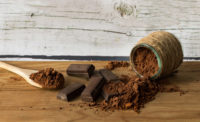Despite all the changes that racked the world — and our corner of it — these past 12 months, as dairy developers survey the trends and technologies that will shape their R&D efforts in 2018, one theme looms above all others: clean labeling.
Milk | Cheese | Cultured | Ice Cream | Butter | Non-dairy Beverages | Ingredients | Exports
Or, to paraphrase another esteemed writer — Pete Townshend — “Meet the new trend, same as the old trend.”
Yes, clean labels are still here. But it’s not so easy to create “simple” dairy products. A heap of science, technology and ingenuity goes into designing formulations that tick consumers’ back-to-basics boxes while meeting our basics for stability, safety, shelf life and sensory appeal.
So we owe a debt to ingredient suppliers; their innovations help us get that much closer to “clean.” Scrubbing dairy may present challenges, said Kurt Riethman, application manager – sweet flavors for Sensient Flavors, Hoffman Estates, Ill., but “new technologies and better processes create opportunities to overcome them.”
The evolution of ‘clean’
Those opportunities are everywhere. Citing a July 2017 HealthFocus International survey of consumers in Europe, the Americas and Asia-Pacific, Pam Stauffer, global marketing programs manager, Cargill, Wayzata, Minn., noted that “more than 65% of respondents consider it important that they recognize the ingredients on product labels, and that those ingredients be ones they would use at home.”
Yet ingredient familiarity is only one criterion by which consumers judge a product’s “cleanliness.” “Chemical-sounding” inputs and anything “artificial” always raise alarms with label readers, said Claus Bukbjerg Andersen, category and application manager, Arla Foods Ingredients, Viby, Denmark.
And the definition of clean label has expanded from that of only five years ago.
“Once upon a time,” Bukbjerg Andersen said, “an ingredient was considered clean simply if it was derived from a natural source. But consumers now have more questions about the integrity of that source: ‘Okay, so the raw material is natural — but is it also wholesome and safe?’ That’s becoming just as important.”
Jon Peters, president of BENEO Inc., Parsippany, N.J., added that the concept of “farm to fork” is something heard a lot in the dairy industry. International Food Information Council Foundation research found that consumers aren’t just interested in the number and familiarity of ingredients on a label, he noted; they also want to know “where the food comes from, how it’s produced and if manufacturers are committed to sustainability and reducing food waste.”
Function matters
That’s a tall bill to fill — and companies are redirecting entire departments toward filling it. But formulators’ job is to formulate, and when doing so “cleanly,” they invariably run up against the central conundrum of the endeavor: Manufacturers started using “unclean” ingredients for a reason.
Jon Hopkinson, senior application scientist, DuPont Nutrition & Health, New Century, Kan., pointed to the “primary requisites for developing any food product” — safety, nutrition, flavor, texture, shelf life, packaging and economy. All, he argued, are “made difficult in some way by limiting ingredient options to ‘clean.’ In nearly every case, substituting a cleaner ingredient for an unclean one increases the cost of the product and leaves the developer with a product that needs to be ‘fixed’ in some way — and sometimes there is no fix.”
Consider yogurt texture. Manufacturers traditionally have stabilized it with modified starches and gelatins that “could stand up to the intense thermal process and high-shear conditions of yogurt production while still delivering the viscosity, gel structures and mouthfeel that most consumers have come to expect,” explained Brian Surratt, senior scientist – dairy applications, Cargill Texturizing Solutions.
Fermented dairy introduces another set of challenges. Yogurt, sour cream and buttermilk are fermented to a pH of 4.5 to 4.6 during production, but drop to a pH of 4.0 or lower over their shelf life.
“Because the isoelectric point of milk proteins is 4.6,” Surratt said, “their interactions change as the pH shifts and cause textural changes often seen as water that’s ‘wheyed off.’” Here again, he said, starches, hydrocolloids and gelatin “traditionally held things together.”
But today’s consumers would rather they didn’t.
“The past few years have taught us that it’s sensible to avoid ingredients that sound like they’re from a chemistry set,” Bukbjerg Anderson observed. Even so, “the fact remains that these ingredients deliver certain functionalities that improve the appearance, taste, texture or shelf life of formulations.”
Good, clean fun
The bright side is that dairy is in a great position to transition to clean, according to Bukbjerg Andersen.
“Most people see dairy products on the whole as natural and healthy,” he said, “and something they value in their diets. The connection with milk is strong, and they view milk, quite rightly, as a very natural raw material.”
Ingredients made from milk benefit from that association, too. For example, in addition to being “natural, derived from milk and wholesome and safe,” whey proteins help formulators trim fat from yogurt, desserts and cheese “without impacting taste or texture,” Bukbjerg Andersen said. Even better, they’re the sine qua non for sports nutrition, thanks to their excellent protein quality and full complement of essential amino acids and branched-chain amino acids.
Denis Neville, CEO of CoreFX Ingredients, Chicago, added that dry cultured dairy and cheese ingredients can also “drop in for less-clean alternatives.” These clean ingredients lend a “true dairy” flavor and appealing texture, he said, “because real dairy and cheese, when dried, contribute a lot of functional protein and creamy milkfat.”
Feeling our way to clean texture
Demands to clean labels and reduce fat take their toll on body and mouthfeel. Among the clean options that restore these properties is chicory root fiber. Rich in inulin fructans, it can create a creamy or milky texture, mimic fat, supply bulk and act as a masking agent, Surratt said. And with suppliers offering ingredients that differ in their solubility, degree of polymerization and relative sweetness, dairy developers can tailor their choices to their formulation needs.
“Chicory root fiber also has a negligible impact on glycemic index,” Surratt added, “which is important for reduced- or no-added-sugar applications.”
Peters’ company derives a number of inulin ingredients from chicory root, too. He calls them tools for getting “fat out and fiber in.” Inulin provides mouthfeel and body “in a manner similar to fat droplets,” he noted, and its neutral profile “means it doesn’t affect flavor or taste and is easily incorporated into a variety of dairy applications.”
Peters also suggested native rice starch as a clean-label texturizer, particularly in low-fat dairy systems. His company markets a native rice starch “with enhanced functionalities in terms of process stabilization,” which he said “adds soft and smooth textures and additional creaminess while maintaining product stability.”
Angelina De Castro, senior manager, wholesome innovation for Westchester, Ill.-based Ingredion Incorporated, noted that functional flours are making a name for themselves as clean texturizers that “help dairy developers do more with less.” Internal consumer research found that U.S. and Canadian consumers recognize the term “flour” and associate it with minimal processing, she said, with rice and tapioca flours ranking especially highly in “natural” perception and acceptability.
Her company markets its own line of functional tapioca and rice flours that “provide exceptional flavor release and enhanced creamy textures to let food manufacturers reduce fat content and improve nutrition,” she said.
Culture club
Bacterial cultures have been modifying dairy texture for as long as farmers have been milking their livestock. But these cultures’ utility deserves special attention now that artificial texturizers are “out” and fermentation is very “in.”
“In a properly designed process, today’s cultures can deliver extra-high texture, which is important for set and stirred yogurt,” said Mirjana Curic-Bawden, Ph.D., principal scientist, application manager, fermented milk and probiotics, cultures & enzymes for Chr. Hansen, Milwaukee. Smart cultures can also create the “high smoothness” desirable in drinkable yogurts. Cultures specifically designed for drinking yogurts can even maximize stability by minimizing separation without added stabilizers.
Twenty-first-century cultures do double-duty as preservatives, too. When specially selected to protect against yeast and mold, cultures can “maintain freshness throughout shelf life,” Curic-Bawden noted, and reduce or eliminate the need for “artificial” preservatives such as potassium sorbate.
Sweet solutions
Another trick up cultures’ sleeve: added-sugar reduction. When tag-teamed with lactase enzyme, they can “digest” the 3% to 5% lactose that may remain in yogurt following fermentation, hydrolyzing the disaccharide into its relatively sweeter glucose and galactose monomers, Curic-Bawden explained.
And increasing or even maintaining sweetness without adding sugar may be the clean-formulation moon shot of 2018.
“Upcoming changes to Nutrition Facts panels will shift the paradigm for consumers,” declared Wade Schmelzer, principal food scientist at Cargill. “The inclusion of added sugars will have an impact on consumer perception and purchase decisions.”
They’ll likely look to stevia ingredients in the process, and improvements in the sweetener’s taste profile — as well as strategic blends with other high-intensity options — will be linchpins in their success.
Monk fruit extract is a frequent strategic stevia partner. As Thom King, president and CEO of Icon Foods, Gresham, Ore., explained, stevia and monk fruit blends “hit the top of a bell curve” in taste, maximizing sweetness while mitigating off notes.
Sweetness modulation systems can help here, too.
Whereas stevia and monk fruit have an immediate sweet effect that tapers off — exposing off notes — sweetness modulation systems “take a second to build and then the sweetness lingers before trailing off,” King explained. Paired with stevia and monk fruit in taste tests, such systems have “successfully masked all of the pronounced off notes, particularly in frozen dairy applications where clean label is desired.”
So it’s clear that formulating clean-label dairy involves juggling many moving parts. But, as Mark Cornthwaite, marketing manager – clean label, DuPont Nutrition & Health, reflected, clean labeling not only is here to stay, but also will evolve. Keeping up with ingredient innovations, therefore, “will be key for developers,” he said.
Milk | Cheese | Cultured | Ice Cream | Butter | Non-dairy Beverages | Ingredients | Exports






